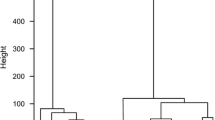Abstract
Renaissance lustred majolica shards from Gubbio and Deruta (Central Italy) were investigated in order to point out differences in chemical and mineralogical composition between these two very similar Italian potteries and furthermore to find correlations with the local raw clay materials probably used for their production. Chemical and mineralogical analysis on the ceramic body were performed by ICP-OES (inductively coupled plasma optical emission spectroscopy) and XRD (X-ray diffraction), respectively. Investigation of the ceramic body revealed significant differences on calcium content indicating that it could be used as a marker for the two different productions.
A separation of the ceramic shards in groups, on the base of their provenance, has been achieved applying to the data set formed by the chemical compositional data some multivariate techniques, such as PCA (principal component analysis) and HCA (hierarchical cluster analysis).
Even the mineralogical composition of the groups shows very interesting features, differing Gubbio production from Deruta one for the presence of several mineralogical species.
The investigations carried out on clays that were collected in the two geographical places have confirmed these differences. In fact, the clay materials have a chemical composition coherent with that one found in the shards. Firing tests performed by heating these clay in different conditions (temperature and soaking time) have shown a different behaviour as concerns the formation of the minerals and it is compatible with the shard composition found. From the comparison between the fired clay and the ceramic shards, some assumptions about the firing conditions applied by the ancient potters have been drawn.
Similar content being viewed by others
References
A. Caiger-Smith, Lustre Pottery: Technique, Tradition and Innovation in Islam and the Western World (Faber and Faber, London, 1985)
G. Padeletti, P. Fermo, Appl. Phys. A 76, 515 (2003)
C. Piccolpasso, Li Tre Libri dell’Arte del Vasaio, 1557 (Edizioni all’insegna del Giglio, Firenze, 1976)
M.S. Tite, J. Archaeol. Sci. 36, 2065–2080 (2009)
M.S. Tite, Archaeometry 50, 216–231 (2008)
M.J. Baxter, Exploratory Multivariate Analysis in Archaeology (Edinburg University Press, Edinburg, 1994)
S. Conti, D. Fontana, C.C. Lucente, Facies 54, 479–498 (2008)
B. Moroni, C. Conti, Appl. Clay Sci. 33, 230–246 (2006)
G. Padeletti, P. Fermo, Appl. Phys. A 77, 125–133 (2003)
M.J. Baxter, C.E. Buck, Data handling and statistical analysis, in Modern Analytical Methods in Art and Archaeology, ed. by E. Ciliberto, G. Spoto. Chemical Analysis Series, vol. 155 (Wiley, New York, 2000), pp. 681–742
M.J. Baxter, Archaeometry 50, 968–982 (2008)
P. Fermo, E. Delnevo, M. Lasagni, S. Polla, M. de Vos, Microchem. J. 88, 150–159 (2008)
A.M. Pollard, C. Heron, Archaeological Chemistry. RSC Paperback (The Royal Society of Chemestry, Bradford, 1996). Chap. 4
R. Heimann, Archeomaterials 3, 123–148 (1989)
G. Cultrone, C. Rodriguez-Navarro, E. Sebastian, O. Cavalla, M.J. De La Torre, Eur. J. Mineral. 13, 621–634 (2001)
A. Ravaglioni, A. Krajewski, Chimica Fisica Tecnica e Scienza dei Materiali Antichi Ceramici e Vetrosi (Museo Internazionale delle Ceramiche, Faenza, 1989)
N. Cuomo Di Caprio, Ceramica in Archeologia 2, Antiche Tecniche di Lavorazione e Moderni Metodi di Indagine (L’Erma di Bretschneider, Roma, 2007)
N. Cuomo Di Caprio, La Ceramica in Archeologia, Antiche Tecniche di Lavorazione e Moderni Metodi di Indagine (L’Erma di Bretschneider, Roma, 1985)
Author information
Authors and Affiliations
Corresponding author
Rights and permissions
About this article
Cite this article
Padeletti, G., Fermo, P. A scientific approach to the attribution problem of renaissance ceramic productions based on chemical and mineralogical markers. Appl. Phys. A 100, 771–784 (2010). https://doi.org/10.1007/s00339-010-5689-x
Received:
Accepted:
Published:
Issue Date:
DOI: https://doi.org/10.1007/s00339-010-5689-x



